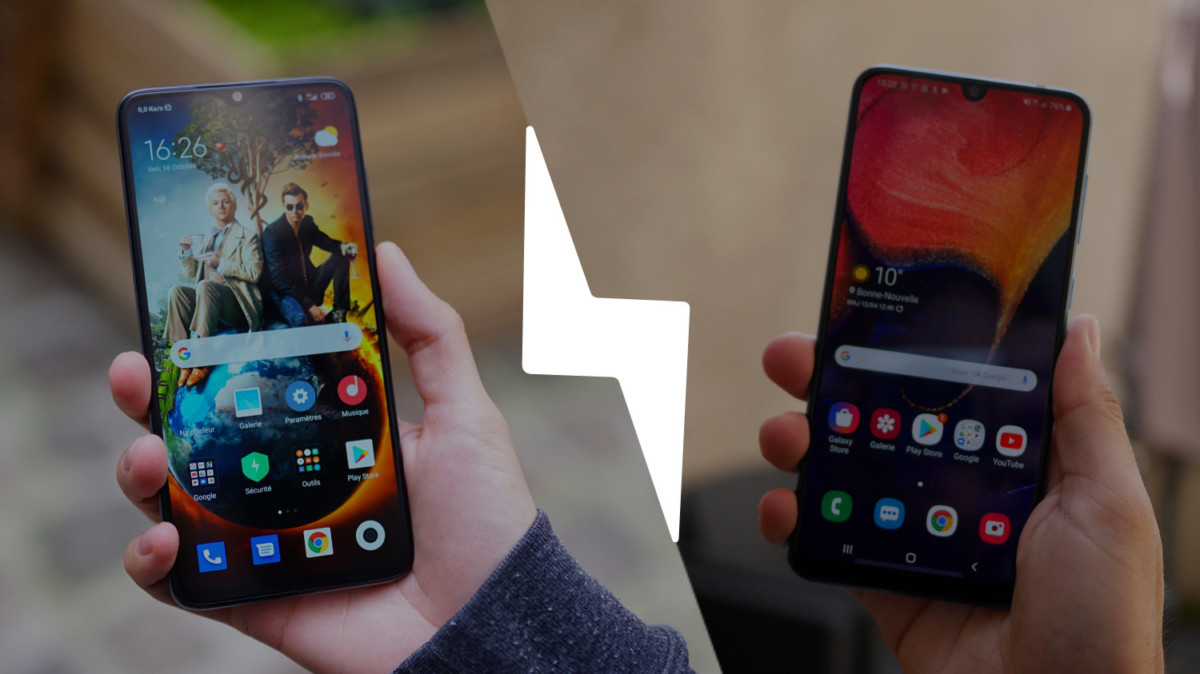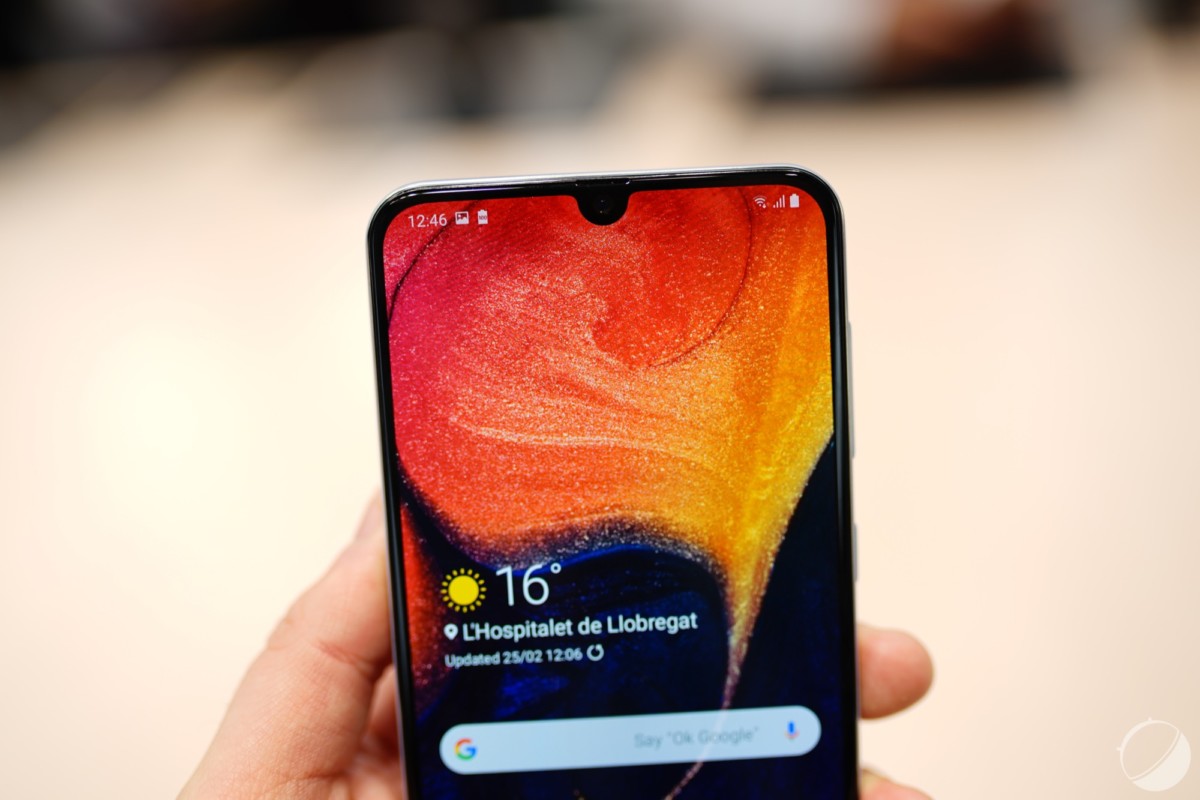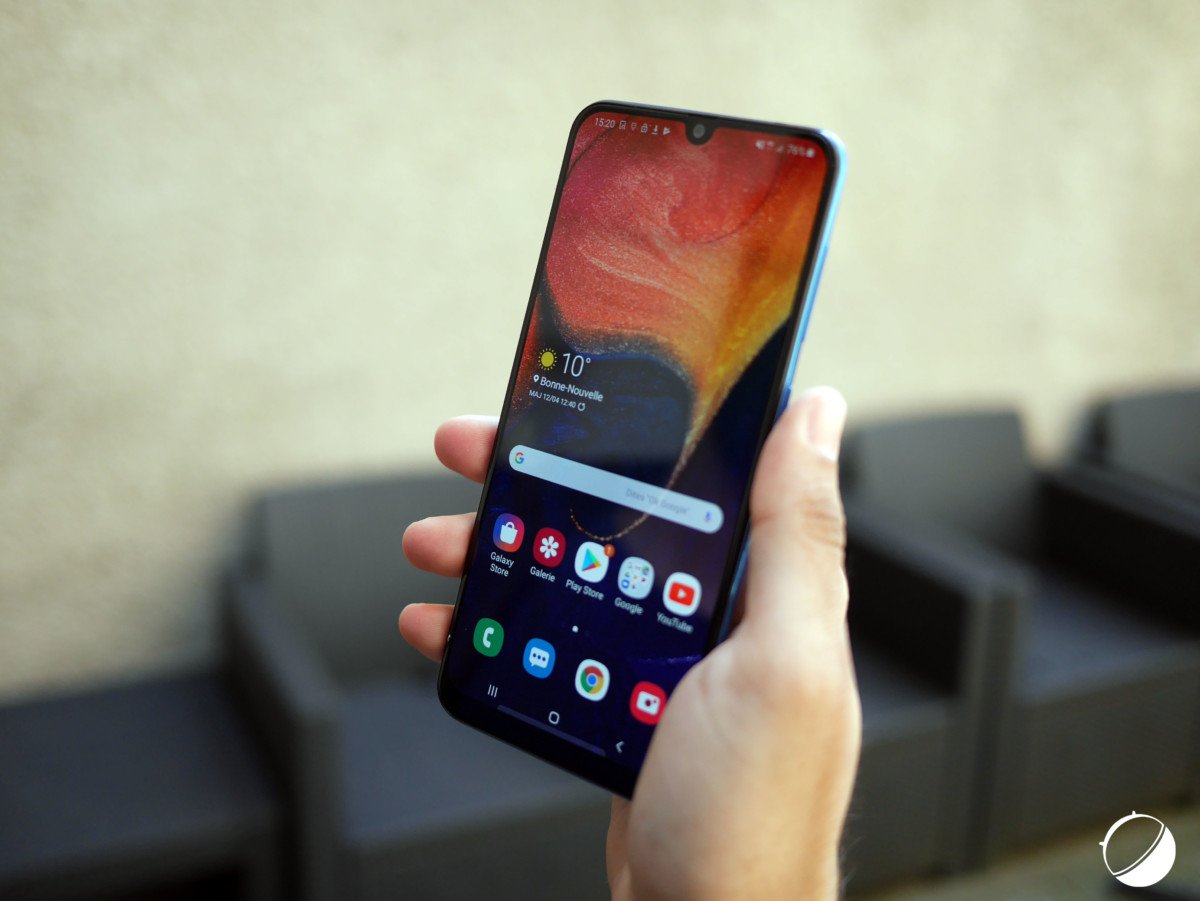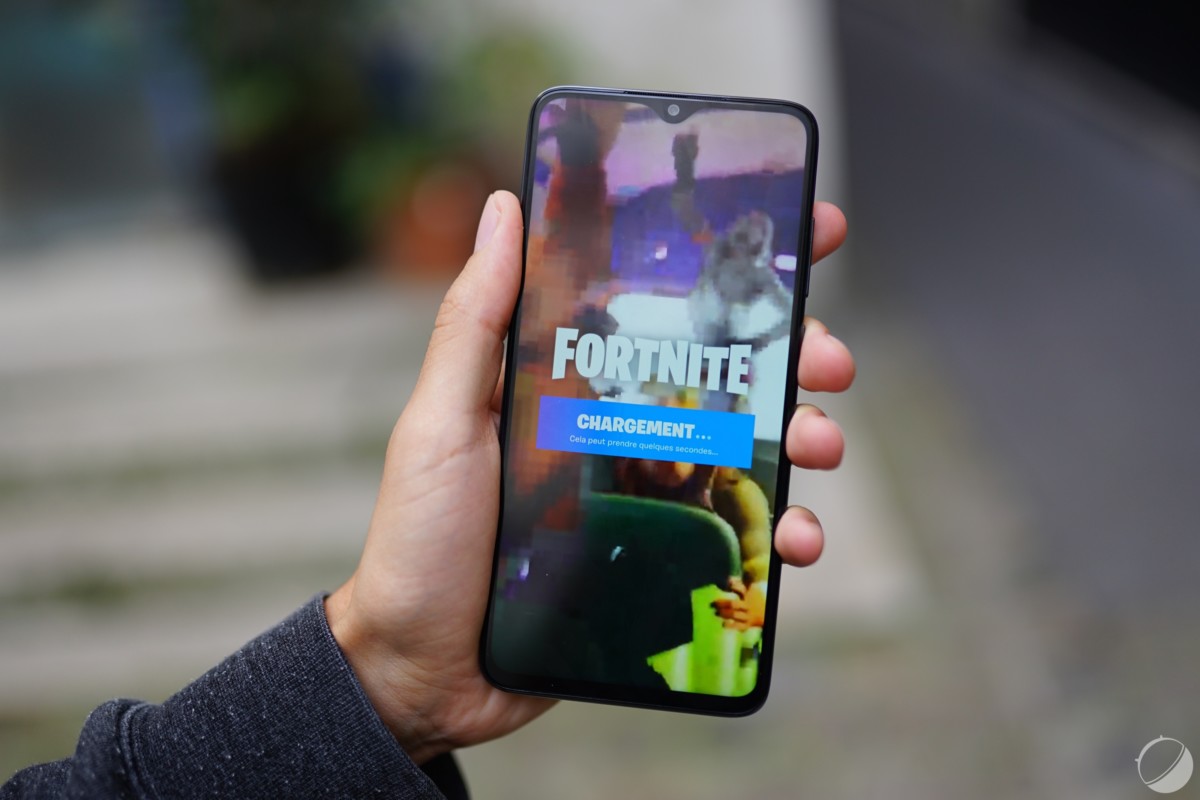[ad_1]
Around 250 euros, two smartphones stand out clearly: the Xiaomi Redmi Note 8 Pro and the Samsung Galaxy A50. But which one is the best? Comparative!

Released at 350 euros last April, the Samsung Galaxy A50 quickly became a very good smartphone. Six months later, its price has dropped and it is now available for one hundred euros less, making it an excellent value for money. His domination was almost complete until the recent arrival of Xiaomi Redmi Note 8 Pro on the same price segment.


The question then arises: who of Samsung Galaxy A50 and Xiaomi Redmi Note 8 Pro is the best smartphone according to your criteria? Design, screen, performance, software, battery, camera … we compare the Galaxy A50 and the Redmi Note 8 Pro point by point!
Data sheets
| Model |
Xiaomi Redmi Note 8 Pro |
Samsung Galaxy A50 |
|---|---|---|
| OS version |
Android 9.0 |
Android 9.0 |
| Builder interface |
MIUI |
N / C |
| Screen size |
6.53 inches |
6.4 inches |
| Definition |
2340 x 1080 pixels |
2340 x 1080 pixels |
| Pixel density |
N / C |
403 dpi |
| Technology |
LCD |
OLED |
| SoC |
Helio G90T |
Exynos 9610 |
| Graphics Chip (GPU) |
ARM Mali G76 |
ARM Mali G72 MP3 |
| RAM memory |
6 GB, 8 GB |
4GB |
| Internal memory (flash) |
128 GB, 64 GB |
64 GB, 128 GB |
| Camera (backpack) |
Sensor 1: 64 Mpx |
Sensor 1: 25 Mpx |
| Camera (front) |
20 MP |
25 MP |
| Video recording |
1080p |
4K |
| Wireless |
Wi-Fi 5 (ac) |
Wi-Fi 5 (ac) |
| Bluetooth |
5.0 |
5.0 |
| networks |
LTE, HSPA, GSM |
LTE, HSPA, GSM |
| Supported bands |
2100 MHz (B1), 800 MHz (B20), 1800 MHz (B3), 2600 MHz (B7), 700 MHz (B28) |
2100 MHz (B1), 800 MHz (B20), 1800 MHz (B3), 2600 MHz (B7) |
| NFC |
Yes |
Yes |
| Fingerprint sensor |
Yes |
Yes |
| Ports (Inputs / Outputs) |
USB Type-C |
USB Type-C |
| Drums |
4500 mAh |
4000 mAh |
| Dimensions |
76.4 x 161.35 x 8.79mm |
74.7 x 158.5 x 7.7mm |
| Weight |
200 grams |
158 grams |
| Colors |
Black, White, Blue |
Black, White, Blue, Orange |
| Price |
249 € |
266 € |
|
Product sheet |
Product sheet |
Design: a "heavy" difference
On this price range, we do not expect that smartphones are particularly original. They usually repeat the design of flagships last year – or even before – without too much innovation. Do not wait here mechanism particularly developed to remove the notch, the two smartphones are very similar when viewed from the front with their relatively thin edges and notch in water drop.

Always a little notch
To differentiate a Galaxy A50 from a Redmi Note 8 Pro, it is necessary to return these smartphones to focus on their backs. Plastic "glass effect" on the first, and glass – plastic effect – on the second, the back shell is slightly curved on the sides to perfectly match the curves of the hand and offer a pleasant grip.
It is at the level of the template that the difference is really played in the end. 8.79 mm thick and 200 grams on the scale for the Redmi Note 8 Pro, and 7.7 mm for 158 grams for the Galaxy A50. The difference is not negligible. For comparison, 200 grams is the weight of the Galaxy Note 9. This thickness and weight can still be explained by a battery difference, but we will come back to it in the appropriate part.

Xiaomi Redmi Note 8 Pro back
The biometric recognition is also to the advantage of Samsung since the fingerprint sensor is housed under the screen, where Xiaomi has chosen to integrate the back. This choice would not be a problem if the finger should not land just under the photo module, dirtying it for sure. Gymnastics is necessary to get used to his placement.
KO by AMOLED
In the left corner, the Chinese challenger displays a diagonal of 6.53 inches in Full HD + on a very good LCD panel IPS, bright and contrasted. However, there is a temperature too high and a delta E (difference in color with reality) flies a little. A point that would shock on a high-end smartphone, but that does not seem a problem here.

An unbeatable screen
In the right corner, the all-Korean champion with a diagonal of 6.4 inches in Full HD +. We are here on an AMOLED technology that offers infinite contrasts and a brightness that rises to 622 cd / m². It's dazzling! Beside that, the colors are not extremely accurate, but with a temperature of 7000 K against 7970 K for Xiaomi, it is closer to the 6500 K that is expected on a slab excellently calibrated.
In both cases we are on a very good slab for the price, but it is difficult to resist the wealth of the AMOLED and Samsung knows it well.
MIUI is late
If we look forward to seeing what Xiaomi is preparing with MIUI 11 (which will arrive on the Redmi Note 8 Pro by the end of the year), the version 10 that equips the smartphone today is still far from convincing us . The functionality may be many and fluidity to go, especially because of the many animations that bring a lot of life to the interface, there are still many frustrating points on this version of the system. To have an application drawer on the Redmi Note 8 Pro, you will have to go through an alternative launcher, antivirus scan Is triggered when you want to download an app on the Google Play Store. An option that will be disabled very quickly from the first launch of the phone.


The Samsung Galaxy A50 on its side also runs on Android 9 Pie (a rumor indicates that it will be updated to Android 10, but no date is specified), but with the UI One interface, as on the Galaxy S10 . The interface is generally fluid, even if the animations are too loaded, and everything has been positioned at hand to make the use more ergonomic.
Xiaomi relies on power
If there is one point on which the Redmi Note 8 Pro makes no concessions, it is on the power. Whether on benchmarks using the raw computing power of the CPU (PCMark) or those using GPU graphics (3DMark, GFxBench …), the Redmi Note 8 generally displays twice the performance of the Samsung Galaxy A50. It's a real fool!

To get there, it sits on a MediaTek Helio G90T SoC coupled to 6 GB of RAM where the Samsung Galaxy A50 embeds a SoC Exynos 9610 and 4 GB of RAM. The bet seems successful since even on Fortnite, theframerateremains firmly anchored on its 30 fps. Same on CoD Mobile.
In short, the performance / price ratio of the Xiaomi Redmi Note 8 is simply amazing and knows no competitor to date.
Versatility at a low price
As for the photo, Samsung and Xiaomi rely on versatility with multiple sensors. The Galaxy A50 is a 25-megapixel main sensor, a second 5-megapixel for depth effects (portrait mode) and a last 8-megapixel for ultra wide-angle focal length. For the Redmi Note 8 Pro, Xiaomi put on a main 64 MP, 2 MP for depth, an ultra-wide 8-megapixel, and finally a 2-megapixel sensor dedicated to the macro effect. We are therefore more or less similar configurations, with still a clear advantage for Xiaomi on paper.
And this advantage, the Redmi Note 8 Pro proves it also in the photos. Its main sensor displays many details and handles light and contrast very well in daylight. At night, it struggles a little more and pushes the microcontrastes which gives a surreal HDR effect in addition to halos of light that start from absolutely all light sources. Its other modules are less exploitable, but are always interesting to offer a different point of view for photos reserved for social networks. Avoid zooming too much in the image, otherwise you will quickly see the limitations of the sensor.
As for the Samsung Galaxy A50, it has been said, it is less good on the main sensor. The difference in the number of pixels is blatant in broad daylight, but for a smartphone at this price, it remains very good, especially on the management of light that can withstand a backlight without flinching. At night, however, we oscillate between the porridge of pixels and contrasts pushed artificially that make the scenes much too bright and yellowed and thinned colors.
The ultra-wide angle in turn lacks sharpness, and at night it also happens much less to capture the light than the main sensor. Here too, it is more for very specific needs and reserved for social networks.
In the end, the Redmi Note 8 Pro always comes out better than its Korean counterpart, whatever the situations, even when the result is difficult.
A gargantuan life
The Samsung Galaxy A50 is the descendant of a long line of smartphones known for their autonomy. With its 4000 mAh battery, we expected it to be long, and we were not disappointed. Whether you want to watch video, play games or simply browse social networks, the Galaxy A50 will accompany you for long hours, and can even take up to 2 days of use.
The Xiaomi Redmi Note 8 Pro meanwhile is also the successor of a smartphone known for its longevity between two charges and its accumulator of 4500 mAh takes it even further. At the end of the two days, he will leave you with another 20% of autonomy.
Both are charged with USB-C, but the Galaxy A50 comes with a 10W charger, against 18W for the Redmi Note 8 Pro. The battery of the first being a little smaller, it recharges completely more quickly.
The look against functionality
If you look at these two smartphones from a purely aesthetic point of view, the Samsung Galaxy A50 is doing better, including its beautiful AMOLED screen and its interface better arranged. On all other points, those who often really count, is the Xiaomi Redmi Note 8 Pro who is ahead. Whether performance, photo or battery, Xiaomi has delivered a master job and continues to dominate this price range.
No doubt, there are two very good smartphones available at an affordable price, but if you had to choose one, the Xiaomi Redmi Note 8 Pro seems to be a better compromise.
To know more about these phones, you can consult our complete tests:
Price and availability
The Xiaomi Redmi Note 8 Pro is officially offered from 249.90 euros for the version with 6 GB of RAM and 64 GB of storage.
Where to buy Xiaomi Redmi Note 8 Pro at the best price?
The Samsung Galaxy A50 is sold in France at the recommended price of 349 euros, but it is regularly found between 275 and 300 euros.
Where to buy the Samsung Galaxy A50 at the best price?
[ad_2]
